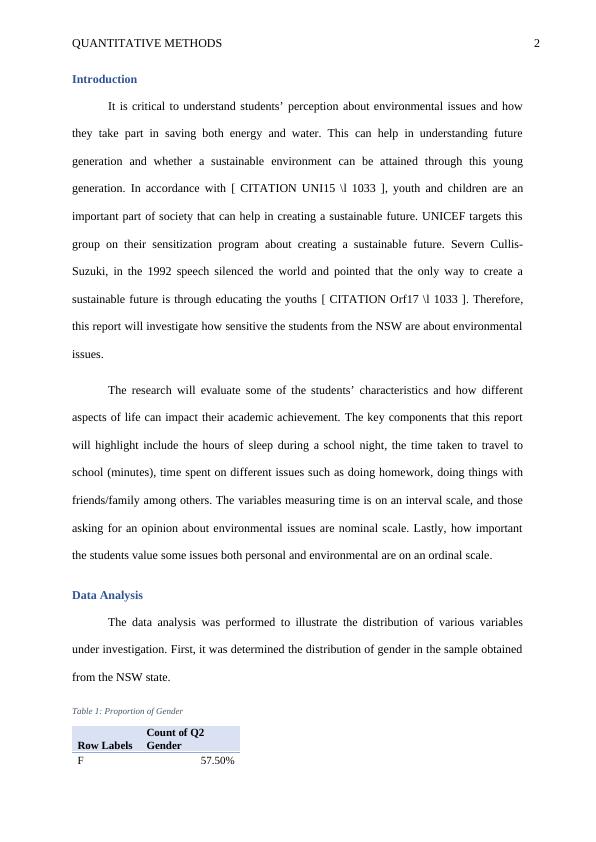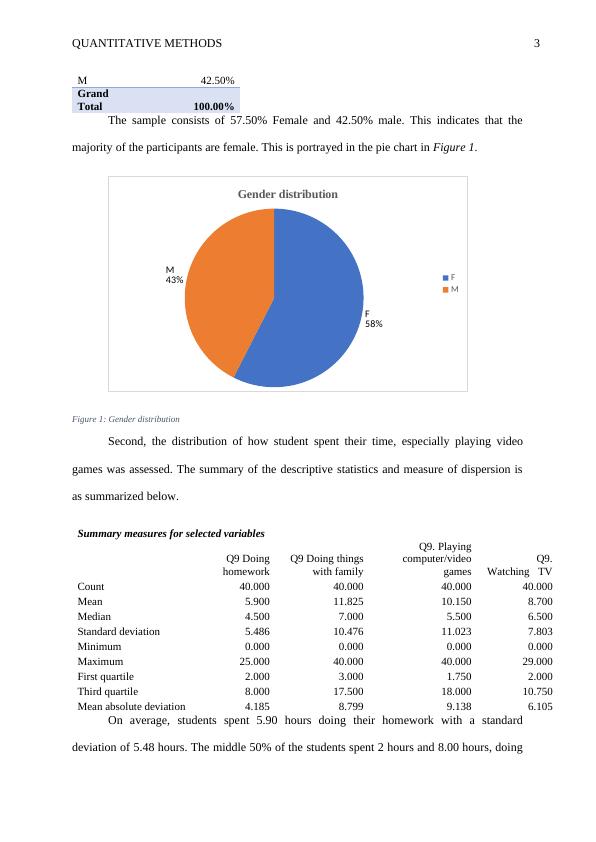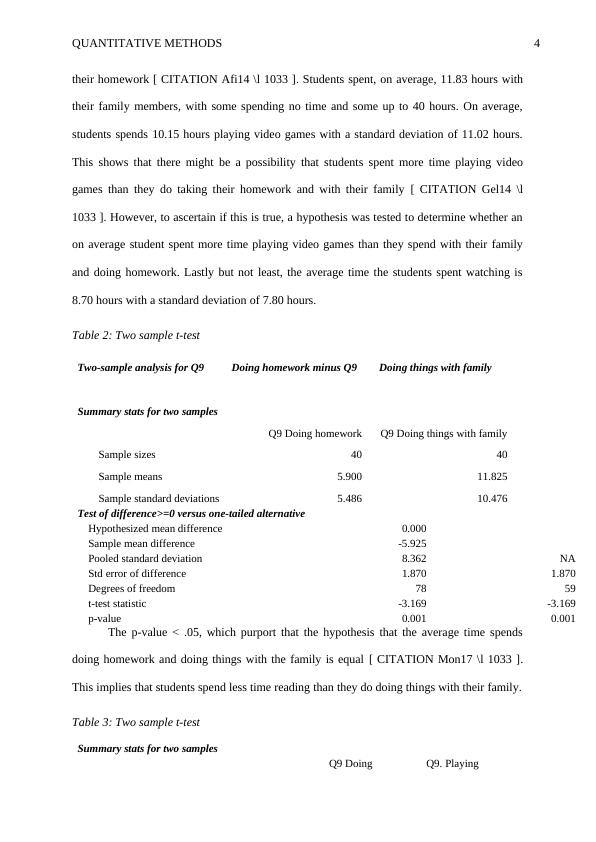Quantitative Methods for the Study of Environmental Issues in High School Students
Added on 2020-04-01
11 Pages2151 Words249 Views
Running head: QUANTITATIVE METHODS1Quantitative MethodsName:Institution:

QUANTITATIVE METHODS 2IntroductionIt is critical to understand students’ perception about environmental issues and howthey take part in saving both energy and water. This can help in understanding futuregeneration and whether a sustainable environment can be attained through this younggeneration. In accordance with [ CITATION UNI15 \l 1033 ], youth and children are animportant part of society that can help in creating a sustainable future. UNICEF targets thisgroup on their sensitization program about creating a sustainable future. Severn Cullis-Suzuki, in the 1992 speech silenced the world and pointed that the only way to create asustainable future is through educating the youths [ CITATION Orf17 \l 1033 ]. Therefore,this report will investigate how sensitive the students from the NSW are about environmentalissues. The research will evaluate some of the students’ characteristics and how differentaspects of life can impact their academic achievement. The key components that this reportwill highlight include the hours of sleep during a school night, the time taken to travel toschool (minutes), time spent on different issues such as doing homework, doing things withfriends/family among others. The variables measuring time is on an interval scale, and thoseasking for an opinion about environmental issues are nominal scale. Lastly, how importantthe students value some issues both personal and environmental are on an ordinal scale. Data AnalysisThe data analysis was performed to illustrate the distribution of various variablesunder investigation. First, it was determined the distribution of gender in the sample obtainedfrom the NSW state.Table 1: Proportion of GenderRow LabelsCount of Q2 GenderF57.50%

QUANTITATIVE METHODS 3M42.50%Grand Total100.00%The sample consists of 57.50% Female and 42.50% male. This indicates that themajority of the participants are female. This is portrayed in the pie chart in Figure 1.F58%M43%Gender distributionFMFigure 1: Gender distributionSecond, the distribution of how student spent their time, especially playing videogames was assessed. The summary of the descriptive statistics and measure of dispersion isas summarized below. Summary measures for selected variablesQ9 DoinghomeworkQ9 Doing thingswith familyQ9. Playingcomputer/videogamesQ9.Watching TVCount40.00040.00040.00040.000Mean5.90011.82510.1508.700Median4.5007.0005.5006.500Standard deviation5.48610.47611.0237.803Minimum0.0000.0000.0000.000Maximum25.00040.00040.00029.000First quartile2.0003.0001.7502.000Third quartile8.00017.50018.00010.750Mean absolute deviation4.1858.7999.1386.105On average, students spent 5.90 hours doing their homework with a standarddeviation of 5.48 hours. The middle 50% of the students spent 2 hours and 8.00 hours, doing

QUANTITATIVE METHODS 4their homework [ CITATION Afi14 \l 1033 ]. Students spent, on average, 11.83 hours withtheir family members, with some spending no time and some up to 40 hours. On average,students spends 10.15 hours playing video games with a standard deviation of 11.02 hours.This shows that there might be a possibility that students spent more time playing videogames than they do taking their homework and with their family [ CITATION Gel14 \l1033 ]. However, to ascertain if this is true, a hypothesis was tested to determine whether anon average student spent more time playing video games than they spend with their familyand doing homework. Lastly but not least, the average time the students spent watching is8.70 hours with a standard deviation of 7.80 hours.Table 2: Two sample t-testTwo-sample analysis for Q9 Doing homework minus Q9 Doing things with familySummary stats for two samplesQ9 Doing homeworkQ9 Doing things with familySample sizes4040Sample means5.90011.825Sample standard deviations5.48610.476Test of difference>=0 versus one-tailed alternativeHypothesized mean difference0.000Sample mean difference-5.925Pooled standard deviation8.362NAStd error of difference1.8701.870Degrees of freedom7859t-test statistic-3.169-3.169p-value0.0010.001The p-value < .05, which purport that the hypothesis that the average time spendsdoing homework and doing things with the family is equal [ CITATION Mon17 \l 1033 ].This implies that students spend less time reading than they do doing things with their family.Table 3: Two sample t-testSummary stats for two samplesQ9 DoingQ9. Playing

End of preview
Want to access all the pages? Upload your documents or become a member.
Related Documents
Quantitative Methods Paper | Environmental Issueslg...
|13
|2182
|277
